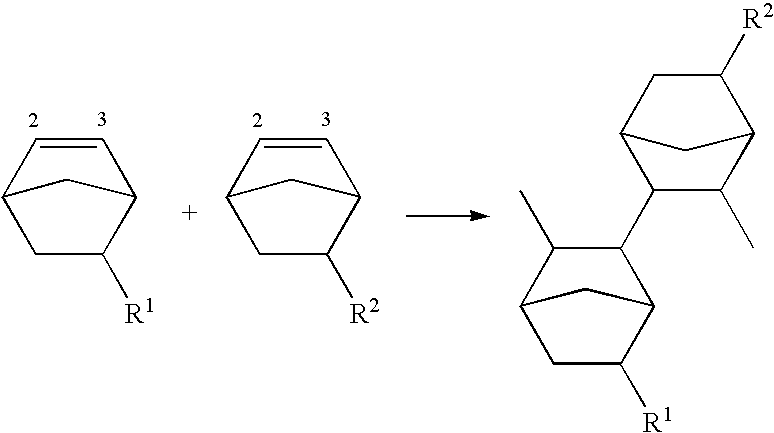Photosensitive compositions based on polycyclic polymers for low stress, high temperature films
a polymer and composition technology, applied in the field of photosensitive polycyclic polymers, can solve the problems of difficult patterning of polymers, difficult to find polymeric materials that are compatible with well established processing methods, and have appropriate mechanical, chemical and thermal properties, for example low internal stress and thermal stability
- Summary
- Abstract
- Description
- Claims
- Application Information
AI Technical Summary
Benefits of technology
Problems solved by technology
Method used
Image
Examples
polymer synthesis examples
Example 1
[0106]A polymer encompassing phenethyl, glycidyl methyl ether and decyl repeat units derived from phenethyl norbornene, glycidyl methyl ether norbornene and decyl norbornene was prepared as follows: To a reaction vessel dried at 110° C. for 18 hours and then transferred to a N2 purged glovebox, ethyl acetate (230 g), cyclohexane (230 g), phenethyl norbornene (14.17 g, 0.071 mol); glycidyl methyl ether norbornene (14.0 g, 0.100 mol) and decyl norbornene (39.50 g, 0.168 mol) were added. The reaction medium was purged of oxygen by passing a stream of dry N2 through the solution for 30 minutes. After the purging was completed, 1.50 g (3.10 mmol) of bis(toluene)bis(perfluorophenyl) nickel dissolved in 8 ml of toluene was injected into the reactor. The reaction mixture was stirred for 18 hours at ambient temperature and then treated with a peracetic acid solution (50 molar equivalents based on the nickel catalyst −150 mmol prepared by combining 57 ml of glacial acetic acid dilute...
example 2
[0108]The procedure of Example 1 was repeated, except that ethyl acetate (200 g), cyclohexane (200 g), phenethyl norbornene (5.06 g, 0.025 mol); glycidyl methyl ether norbornene (14.0 g, 0.077 mol) and decyl norbornene (33.6 g, 0.152 mol) were used. After the purging was completed, 1.45 g (3.00 mmol) of bis(toluene)bis(perfluorophenyl) nickel was dissolved in 8 ml of toluene and injected into the reactor. The reaction was stirred for 6 hours at ambient temperature and then treated with an appropriate peracetic acid solution and washed as in Example 1 above. The polymer was precipitated and recovered as in Example 1 above. After drying, 49.2 g of dry polymer (90% conversion) was obtained. The molecular weight of the polymer was determined by GPC using a polystyrene standard and found to be Mw=84,631, Mn=33,762, polydispersity index (PDI)=2.51. The composition of the polymer was determined using 1H NMR, and found to have incorporated: 10.2 mol % phenethyl norbornene; 31.5 mol % glycid...
example 3
[0109]The procedure of Example 1 was repeated, except that ethyl acetate (200 g), cyclohexane (200 g), phenethyl norbornene (2.36 g, 0.012 mol); glycidyl methyl ether norbornene (12.63 g, 0.070 mol) and decyl norbornene (35.6 g, 0.152 mol) were used. After the purging was completed, 1.33 g (2.74 mmol) of bis(toluene)bis(perfluorophenyl) nickel was dissolved in 7 ml of toluene and injected into the reactor. The reaction was stirred for 6 hours at ambient temperature and then treated with an appropriate peracetic acid solution and washed as in Example 1 above. The polymer was precipitated and recovered as in Example 1 above. After drying, 44.8 g of dry polymer (89% conversion) was obtained. The molecular weight of the polymer was determined by GPC using a polystyrene standard and found to be Mw=92,452 Mn=37,392, polydispersity index (PDI)=2.47. The composition of the polymer was determined using 1H NMR, and found to have incorporated: 6.5 mol % phenethyl norbornene; 30.1 mol % glycidy...
PUM
| Property | Measurement | Unit |
|---|---|---|
| Temperature | aaaaa | aaaaa |
| Temperature | aaaaa | aaaaa |
| Temperature | aaaaa | aaaaa |
Abstract
Description
Claims
Application Information
 Login to View More
Login to View More - R&D
- Intellectual Property
- Life Sciences
- Materials
- Tech Scout
- Unparalleled Data Quality
- Higher Quality Content
- 60% Fewer Hallucinations
Browse by: Latest US Patents, China's latest patents, Technical Efficacy Thesaurus, Application Domain, Technology Topic, Popular Technical Reports.
© 2025 PatSnap. All rights reserved.Legal|Privacy policy|Modern Slavery Act Transparency Statement|Sitemap|About US| Contact US: help@patsnap.com



